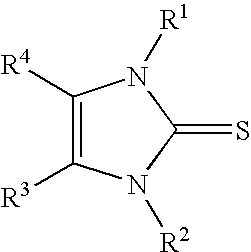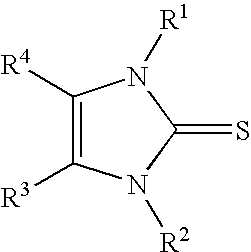Solventless One-Step Process for the Production of Imidazole-2-thiones
a technology of imidazole and two-step process, applied in the direction of organic chemistry, etc., can solve the problems of limited number of bases and solvent-based procedures, and achieve the effect of improving workplace safety
- Summary
- Abstract
- Description
- Claims
- Application Information
AI Technical Summary
Benefits of technology
Problems solved by technology
Method used
Image
Examples
example 1
[0023]Preparation of 1-methyl-3-propylimidazole-2-thione (with potassium carbonate as base): A water-jacketed 500 mL flask equipped with ports for addition of solids and blanketed under a dry-nitrogen atmosphere was charged with 200.00 grams (0.98 moles) of 1-methyl-3-propylimidazolium bromide. Lac sulfur, 31.22 grams (0.98 moles), was added as a single portion and the resulting mixture was heated to 80° C. with vigorous stirring. Solid anhydrous potassium carbonate (134.83 grams, 0.98 moles) was added portionwise with adjustment of the cooling rate so that the reaction mixture was held between 80 and 85° C. Carbon dioxide was evolved as the potassium carbonate was added. After the addition of potassium carbonate was completed, the mixture was stirred for an additional 20 hours. The reaction mixture was filtered to remove the inorganic by-products. The filtrate (146 grams, 96%) was a light brown oil that analyzed (by nmr) as pure 1-methyl-3-propylimidazole-2-thione. Distillation of ...
example 2
[0024]Preparation of 1-methyl-3-propylimidazole-2-thione (with sodium hydride as base): A water-jacketed 1-liter flask equipped with ports for addition of solids and blanketed under a dry-argon atmosphere was charged with 300.00 grams (1.46 moles) of 1-methyl-3-propylimidazolium bromide. Lac sulfur, 46.83 grams (1.46 moles), was added as a single portion and the resulting mixture was heated to 60° C. with vigorous stirring. Sodium hydride 80% dispersion in oil (43.90 grams, 1.46 moles) was added portionwise with adjustment of the cooling rate so that the reaction mixture was held between 60 and 80° C. The reaction is very vigorous and efficient cooling was required. Hydrogen was evolved as the sodium hydride was added. After the addition of sodium hydride was completed, the mixture was stirred for an additional 18 hours. The reaction mixture was filtered to remove the inorganic by-products. The filtrate (226 grams, ˜95%) was a brown oil that analyzed (by nmr) as almost pure 1-methyl...
example 3
[0025]Preparation of 1-methyl-3-propylimidazole-2-thione (with calcium oxide as base): A water-jacketed 1-liter flask equipped with ports for addition of solids and blanketed under a dry-nitrogen atmosphere was charged with 300.00 grams (1.46 moles) of 1-methyl-3-propylimidazolium bromide. Lac sulfur, 46.83 grams (1.46 moles), was added as a single portion and the resulting mixture was heated to 80° C. with vigorous stirring. Calcium oxide (40.93 grams, 0.73 moles) was added slowly at 80° C. After the addition of calcium oxide was completed, the mixture was heated to 105° C. and stirred for an additional 26 hours. Cooling of the reaction mixture below approximately 80° C. resulted in crystallization of large quantities of CaBr2, this should be avoided. At 90° C. 170 mL water was added to extract the calcium bromide by-product. The mixture was quickly cooled to 23° C. and the water / calcium bromide layer was separated from the organics. The organic layer was dried over anhydrous sodiu...
PUM
| Property | Measurement | Unit |
|---|---|---|
| temperature | aaaaa | aaaaa |
| temperature | aaaaa | aaaaa |
| temperature | aaaaa | aaaaa |
Abstract
Description
Claims
Application Information
 Login to View More
Login to View More - R&D
- Intellectual Property
- Life Sciences
- Materials
- Tech Scout
- Unparalleled Data Quality
- Higher Quality Content
- 60% Fewer Hallucinations
Browse by: Latest US Patents, China's latest patents, Technical Efficacy Thesaurus, Application Domain, Technology Topic, Popular Technical Reports.
© 2025 PatSnap. All rights reserved.Legal|Privacy policy|Modern Slavery Act Transparency Statement|Sitemap|About US| Contact US: help@patsnap.com



